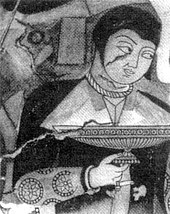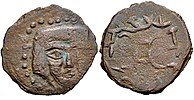Balalyk Tepe
Murals
The theme of the Balalyk-tepe is uniformly related to feasting. The style of the painting is quite different from the native style of Penjikent, Afrasiab or Varakhsha. Although the pervasive theme of the banquet is different from the religious theme of the Buddhist murals of Tokharistan, and the painting do not have a Buddhist character despite the presence of a few elements, some similarities can be found in style and iconography.
The men in the paintings are beardless and the women have rounded features. They are adorned with splendid costumes and beautiful jewelry.
The paintings seem to depict the Hepthalites in the early 6th century CE, before the arrival of the Turks of the First Turkic Khaganate and the consolidation of the Oxus as their southern border in 571 CE, encompassing Balalyk Tepe. Most of the wall paintings were destroyed in the second half of the 6th century (550-600 CE). Very similar Hephthalite types are seen in the paintings of the donors of the Buddhas of Bamiyan, on the ceiling of the 35 meter Buddha.
The paintings of Balalyk Tepe are very similar to those of Dilberjin Tepe, and some from Bamiyan, which both belong about a century earlier to the 5th-6th century CE, or even as early as the 4th century according to some authorities, based on numismatic evidence. The paintings of Balalyk Tepe are also sometimes considered as the oldest of "the large pictorial cycles" in Central Asia.

-
Figure of a banquet, Balalyk Tepe, 6th-7th century CE
-
Balalyk tepe Banquet scene, 6-7th century CE
-
Balalyk tepe Banquet scene, 6-7th century CE
-
Balalyk tepe Banquet scene, 6-7th century CE
Attribution

Many authors have suggested that the figures in the Balalyk Tepe paintings are characteristic of the Hephthalites (450-570 CE). In this context, parallels have been drawn with the figures from Kizil Caves in Chinese Turkestan, which seem to wear broadly similar clothing. The paintings of Balalyk Tepe would be characteristic of the court life of the Hephthalites in the first half of the 6th century CE, before the arrival of the Turks.
The paintings of Balalyk Tepe are also sometimes attributed to the time after the arrival of the First Turkic Khaganate and the Western Turks (571-720 CE), who occupied the region north of the Oxus, including Balalyk Tepe, after 571 CE, while the Sasanians remained to the south. The attribution to the Turks has also been suggested for other sites further south, such as Dokhtar-i-Noshirwan.
Numismatic parallels

Some attempts have been made at identifying similarities between the types of Balalyk Tepe and the portraits on coins of the region. In some coins from Chach, modern Tashkent, rulers appear in portrait, facing right, with a tamgha in the shape of an X, and a circular Sogdian legend. They also often appear with a crescent over the head. It has been suggested that the facial characteristics and the hairstyle of these rulers as they appear on their coinage (round faces, almost plump, with almond-shaped eyes and straight hair cut above the shoulders), are similar to those appearing on the murals of Balalyk Tepe further south.
Michael Fedorov attributed this type of coinage to the Chionites (Hephthalites), who are known to have ruled in Chach (modern Tashkent), at the foot of the Altai Range, between the middle of the 4th century CE to the 6th century CE. The Chionites of Chach disappeared in the 7th century, when the invading Western Turks killed the last Chionite ruler circa 605 CE, to replace him by a Turkish Tegin from the Ashina tribe.
Other authors have attributed these coins to the next period, between 625 and 725 CE, corresponding to the control of the area of Chach by the Western Turks.
See also
References
- ^ Dani, Ahmad Hasan; Litvinsky, B. A. (1996). History of Civilizations of Central Asia: The crossroads of civilizations, A.D. 250 to 750. UNESCO. p. 183. ISBN 978-92-3-103211-0.
- ^ "The exacavations at Balalik Tepe (...) revealed the remains of a small fortified manor that was the seat of a princely Hephthalite clan." in Rowland, Benjamin (1975). The art of Central Asia. New York, Crown. p. 75.
- ^ MUZIO, CIRO LO (2008). "Remarks on the Paintings from the Buddhist Monastery of Fayaz Tepe (Southern Uzbekistan)". Bulletin of the Asia Institute. 22: 199. ISSN 0890-4464. JSTOR 24049243.
- ^ Dani, Ahmad Hasan (1999). History of Civilizations of Central Asia: The crossroads of civilizations: A.D. 250 to 750. Motilal Banarsidass Publ. pp. 151–152. ISBN 978-81-208-1540-7.
- ^ "The Tokharistan school was represented by Balalyk-tepe, Adzhina-tepe, Kafyr-kala; the northern Tokharistan school was found in the Buddhist Temples of Kuva and in Jeti-su" Kurbanov, Aydogdy (2014). "THE HEPHTHALITES: ICONOGRAPHICAL MATERIALS" (PDF). Tyragetia: 317–334.
- ^ Azarpay, Guitty; Belenickij, Aleksandr M.; Maršak, Boris Il'ič; Dresden, Mark J. (January 1981). Sogdian Painting: The Pictorial Epic in Oriental Art. University of California Press. p. 93. ISBN 978-0-520-03765-6.
- ^ Frumkin, Grégoire (1970). Archaeology in Soviet Central Asia. Brill Archive. pp. 116–117.
- ^ "Besides the obvious thematic difference between the Balalyk-tepe banquet scene and the religiously inspired Buddhist cave paintings from Tukharistan, the two are closely connected by style and iconography." in Azarpay, Guitty; Belenickij, Aleksandr M.; Maršak, Boris Il'ič; Dresden, Mark J. (1981). Sogdian Painting: The Pictorial Epic in Oriental Art. University of California Press. p. 92. ISBN 978-0-520-03765-6.
- ^ "A striking parallel to the Balalyk tepe murals is offered by files of donors represented on the right and left walls of the vault of the 34 m Buddha at Bamiyan. (...) The remarkable overall stylistic and iconographic resemblance between the two sets of paintings would argue for their association with the artistic tradition of the Hephthalite ruling classes of Tukharestan that survived the downfall of Hephthalite power in A.D. 577" in "Azarpay, Guitty; Belenickij, Aleksandr M.; Maršak, Boris Il'ič; Dresden, Mark J. (January 1981). Sogdian Painting: The Pictorial Epic in Oriental Art. University of California Press. p. 93. ISBN 978-0-520-03765-6.
- ^ Dani, Ahmad Hasan; Litvinsky, B. A. (January 1996). History of Civilizations of Central Asia: The crossroads of civilizations, A.D. 250 to 750. UNESCO. p. 183. ISBN 978-92-3-103211-0.
- ^ "Furthermore, the style of the later paintings [of Diberjin Tepe], which are comparable to those of Balalyk Tepe and to the oldest frescoes at Panjīkant, both in Sogdia, indicates a date in the 5th-6th centuries C.E., according to some authorities (Belenitskiĭ and Marshak), whereas others argue from the numismatic finds that the final phase cannot have been later than the end of the 4th or the early 5th century C.E. (Vaĭnberg and Kruglikova, 1976; idem, 1984; Pugachenkova, 1984, p. 105).""DELBARJĪN – Encyclopaedia Iranica". www.iranicaonline.org.
- ^ "Among the large pictorial cycles, those of Balaly -tepe are considered the oldest , at least according to the date proposed by the discoverer , L . Al ' baum , who would date the Uzbeco castle and the picture series to the fifth century ." in Myers, Bernard S. (1987). Encyclopedia of World Art. McGraw-Hill. p. 172. ISBN 978-0-910081-01-6.
- ^ Kurbanov, Aydogdy (2014). "THE HEPHTHALITES: ICONOGRAPHICAL MATERIALS" (PDF). Tyragetia: 317–334.
- ^ "Several murals at Dilberjin date from the 5th to the 7th century. A comparison between some of the Dilberjin paintings and those at Kyzyl (“the cave of the 16 swordsmen” and “the cave with picture of Maya”) demonstrates a link between them (Litvinsky 1996, 151)." Kurbanov, Aydogdy (2014). "THE HEPHTHALITES: ICONOGRAPHICAL MATERIALS" (PDF). Tyragetia: 317–334.
- ^ Frumkin, Grégoire (1970). Archaeology in Soviet Central Asia. Brill Archive. pp. 116–118.
- ^ Sims, Eleanor; Marshak, Boris Ilʹich; Grube, Ernst J.; I, Boris Marshak (January 2002). Peerless Images: Persian Painting and Its Sources. Yale University Press. p. 14. ISBN 978-0-300-09038-3.
- ^ Klimburg-Salter, Deborah (1993). "Dokhtar-i-Noshirwan (Nigar) Reconsidered" (PDF). Muqarnas. 10: 355–368. doi:10.2307/1523200. ISSN 0732-2992. JSTOR 1523200.
- ^ Fedorov, Michael (2010). "Chionite Rulers of Chach in the Middle of the Fourth to the Beginning of the Seventh Century (According to the Data of Numismatics)" (PDF). Iran. 48: 59–67. doi:10.1080/05786967.2010.11864773. ISSN 0578-6967. JSTOR 41431217. S2CID 163653671.
- ^ Shagalov, V.D.; Kuznetsov, A.V. (2006). Catalogue of coins of Chach III-VIII AD. Tashkent. pp. 184, 313–315.
{{cite book}}: CS1 maint: location missing publisher (link) - ^ FEDOROV, MICHAEL; KUZNETSOV, ANDREW (2007). "Uzbekistan: A Hoard of Early Mediaeval Chach Coins from Kanka" (PDF). The Numismatic Chronicle. 167: 277–285. ISSN 0078-2696. JSTOR 42666952.







